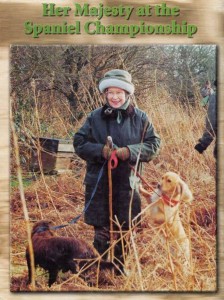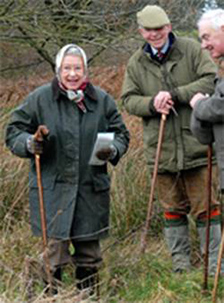UK Kennel Report – Housty Kennels
U.K. KENNEL REPORT
Housty Kennels, Wales, U.K.
By Art Rodger
(Published in Spaniels In The Field Fall 1992)
 Near the seacoast city of Swansea, about one hour drive south from Windmillwood Kennels (reported in the last issue of Spaniels In The Field) lies Housty Kennels, home of owner Mike Shefford. But you don’t just “happen by” – you have to seek it out and know where you are going. When you finally figure out the Wales type roads and hit the final mile you are rewarded by a breathtaking road and view leading to the kennels.
Near the seacoast city of Swansea, about one hour drive south from Windmillwood Kennels (reported in the last issue of Spaniels In The Field) lies Housty Kennels, home of owner Mike Shefford. But you don’t just “happen by” – you have to seek it out and know where you are going. When you finally figure out the Wales type roads and hit the final mile you are rewarded by a breathtaking road and view leading to the kennels.
I met Mike Shefford at the 1990 U.S. Nationals in Illinois and was extended an invitation to visit Housty. Little did we know at the time the troubled circumstances that would exist. On December 20 a convection heater in Mike’s cottage set off a fire in the second floor bedroom that filled the room with fire and smoke. Fortunately Mike was able to save his daughter and then put out the flame before the entire home was gutted. Three weeks later the Rodger’s arrived to find the family living in one room with smoke damaged clothes and furniture everywhere. But with two children and 140 dogs to care for Mike and Gaynor, together with his kennelman and assistant trainer, couldn’t look back. I’m happy to report the all’s well at this writing and the home has been rebuilt and expanded. After all Mike is a tough Welshman born in Numbles, a small town 15 miles down the coast best known for it’s smugglers in the olden days.
Mike’s first Springer was obtained from a family friend when he was 20 and he started breeding two years later. A working gun dog test (20 years ago) put on by the British Steel Corporation Gun Dog Society whetted his appetite and he was hooked, choosing dogs as a career and Spaniels as a specialty. He has been running trials for 16 years, raising, training and handling one Field Trial Champion (Penny of Housty) who later went on to win the English Spaniel Championship in 1989. About five years ago he started judging and has judged about 10 trials to date.
Housty Kennels is located on nine acres of land nestled in a magnificent, remote valley. From his cottage you look out across his training ground of bracken (brown cover when I was there), gorse (a prickly evergreen) and rush (wetland grass), across a winding creek and up an 11,000 acre, bracken covered mountain of “common” land where much of his training is done. The kennels surround the home and are a mixture of old, renovated cow sheds and horse stables and newer wooden kennels. All are “dry” with sawdust on the floor (usually concrete) and open doors to the exterior. The sawdust is removed, and replaced, every day or so. Mike feels the dogs are healthier, and cleaner, in a dry, open environment than they would be with a wet, wash down, kennel arrangement.
The day I was there the kennels had 140 dogs on board, including small puppies. They were predominantly Springers but had a sprinkling of Cockers, Labs and Goldens of all ages and stages of development. Mike keeps a nucleus of brood bitches and averages 30 litters a year. He sells dogs to Wales, England, Ireland, Europe and the U.S.
For the past several years Housty Kennels has exported more Spaniels to the U.S. than any other U.K. kennel, selling exclusively through Mark Hairfield, professional Spaniel trainer from Southhaven Kennels, Rosharon, Texas. Averaging about 20 per year, these trained dogs are roughly 30% field trial prospects and the rest “gundogs”. Some of Mike’s better known exports are:
1.) FC Housty Samson – 0: Dick Turner, H: Mark Hairfield
2.) FC Renegrade of White Bridge – 0: Mike Park, H: Mark Hairfield
3.) Coy of Housty – 0: Mike Park, H: Mark Hairfield
4.) FC/AFC Blaze of Windmillwood – O/H: Russ Smith
5.) AFC Buz of Norehill – O/H: Rick O’Brien

Mike also initially trained Whitlock’s Warrior (later sold to Keith Erlandson and then to Terry Pellow) and Armadale Dan (later sold to Keith Erlandson and then to Janet Christensen).
Mike’s best, and most loved, dog was Penny of Housty whom he made Open Champion in England and who also won the Spaniel Championship in England in 1989. Penny is now with Mark in Texas.
TRAINING SHEFFORD STYLE
As is common in the U.K. training the new puppy starts later than in the U.S.. At about 6 months retrieving with dummy or tennis ball begins, followed by quartering, “hup”, stay, come etc. Steady to dummy and introduction to gunshot begins at 8-10 months. “I don’t believe in any kind of forced retrieving. Spaniels should be natural retrievers and even if you correct problems and the dog turns out to be a good dog and you breed him or her you would be doing the breed harm.”
At 8 months or older (not before) the pup is introduced to cold game. When pup is steady (dummy [see photo below], cold game and rabbit pen) Mike takes his pups to a limited number of driven shoots where he joins the “beaters” line.
Here the pup gets a lot of hunting in and “steady” experience since the pup is not allowed to retrieve. A few of these shoots is great training but too many would be harmful as the pup will begin to lose interest in the flight line since he knows he will soon be able to hunt again. This could develop into a marking problem.
Mike never allows a pup to chase birds although, at an early age he may let a somewhat reluctant dog chase a few rabbits in the rabbit pen to turn him on to game. The pups first shot bird comes between 10 and 14 months depending upon the dog and the time of year.
The rabbit pen is an important part of Mikes training. They teach a pup to hunt, flush and be steady. Since this was my first look at a rabbit pen, and most of you have never seen one, let me describe them to you in detail.
Rabbit pens are simply natural land enclosures, perhaps 1/2 acre up to 5 acres, that let you train your dog in a more controlled environment. Mike’s is 3/4 acre and he likes to keep it small to “wear out less shoe leather” when steadying the pups. They are fenced, have no roof, and are stocked with 8 to 10 domestic rabbits. Wild rabbits would dig out quickly and domestic rabbits will soon learn how to challenge the dogs. Pens are managed to keep as much natural cover as possible. If necessary brush piles possible. If necessary brush piles or other natural type rabbit cover are added.
The pup is brought into the pen and cast off to hunt. The goal is to have the pup find and flush the rabbit and immediately “hup”. This, of course, frequently doesn’t happen the first time and the dog may give merry chase until the rabbit dives in a hole. This gives the handler a chance to chase the dog and return him to the spot of flush with a “brisk” reprimand. When training is in a more advance stage the pup will ignore all other rabbits that may be visible and hunt in front of his handler until he flushes his own rabbit.
Now hear this you aging, elder statesman and overweight youngsters!!!!! Mike figures with the above training program he has to chase an average dog only about 3-4 times before he is steadied. (Providing the basic training has been done properly.)
NEW BREED ON THE
HORIZON – THE FULL
TAILED SPANIEL –
U.S. BEWARE
Mike told me of a new European Community directive stating that tail docking by non-qualified persons must be stopped by July, 1993. It then further defines “qualified” as veterinarians and veterinarian’s nurses. The catch is that the Royal College of Veterinary Surgeons will cancel the license of any “vet” caught docking a dogs tail. There is still hope that this will be modified but the concern is great. A “merry” full tail can become a bloody mess is a hunting situation not to mention the unbalance appearance it would give to the Spaniel.
As our interview came to an end I asked Mike what he was looking for in a Spaniel. His answer was:
1.) Drive in “bramble” (thorny
cover) – must be able to smash
“bramble”
2.) Speed
3.) Style
4.) Perfect mouth
5.) No “squeak” (noise from the mouth)
6.) Ability to take training
7.) Not too nervous – not to independent
“Art, they don’t grow on trees – I’ve had just one, Penny of Housty.”
Mike is very interested in the U.S. market. He feels he has a leg up on some others in that he has been over to the States to witness some trials and to see, first hand, what type of dog we are looking for. As a result he has started a breeding program, specifically to produce U.S. type Springers with the “proper” size, desire to run and hard flush and train suitable prospects on American lines.
You may see him soon. He will be at our National Open Championship this year and one of his ambitions is to breed, train, and prepare a dog and run him in a U.S. trial.



